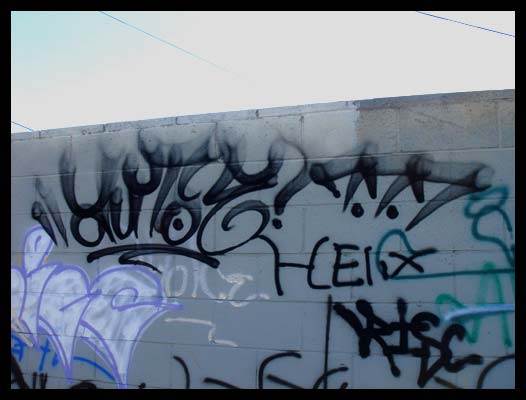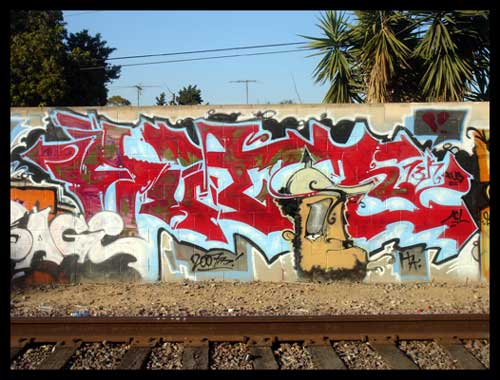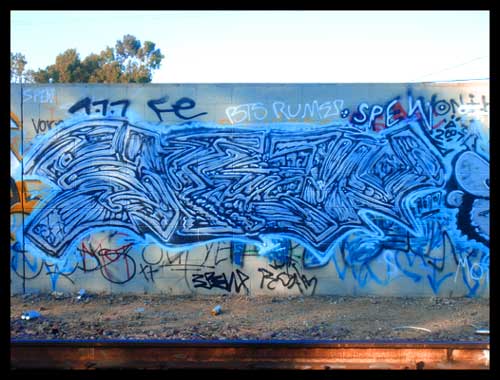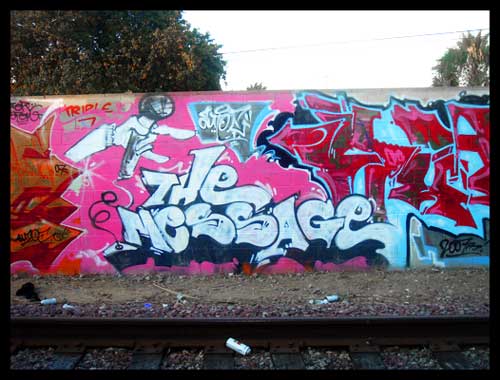 |
||
TEXTING AND GRAFFITTI: Understanding the Reader in Contemporary Art
Graffiti and Texting This question is important because it asks how critical is the social space and context for Graffiti art to exist. Moreover, it questions whether the reader who is able to read a digital graffiti text can read Graffiti on a wall? There is a complexity in the way media profits from street-based art practices such as Graffiti. They portray digital-graffiti as if it was new. Partly, from an economic perspective advertising companies want this to be perceived as new and exciting in order to cash in on the insatiable desire that these systems satisfy for people to be connected. However, looking at Graffiti art, its original practice, its artistic collaboration and construct, one can clearly see that much of this is based on an older practice. One then has to question which has influenced the other, did text-messaging influence Graffiti or did Graffiti influence text messaging? Redefining graffiti art practice in the digital realm may be a smart way for advertising companies to sell the idea of social engagement. However, there is an ideology that erases the unique identity of individuality and artistic craftsmanship. Graffiti is unlike any other form or art--part of street culture and when one speaks of it one needs to talk about its context and its relationship to the city. As an artistic practice this has not been widely discussed. It is easy to misunderstand graffiti as text messaging lingo. The language involved can often seem ambiguous. As such, in this essay I focus on what I call the visual reader. This reader is trained not only in deciphering meaning in abbreviated text messages and sentences, but also is able to read the coded signs of street culture defined by a personal, unique style, history, social and economic positioning within American popular culture. This essay will focus on the street culture rooted in the city of Los Angeles, filtered through the experience of two local graffiti artists, Spew and Autoe. My intent here is that by analyzing an older and then a younger generation of Graff artists and readers, contextualizing it within the time change of digital culture and cell phone usage, I hope to expose a critical discussion in terms of artistic practice.
“Untitled Tagg” by Autoe THE READER Older Graffiti Readers: The City, Space and Collaborating In making a piece Graff artists worked collaboratively, found a wall, a train, a bench and any other public object to draw on. They carried their backpacks full of spray cans, sketchbooks, pencils, and markers. In the process of drawing, they checked each other’s work, sometimes responding to each other’s style or imagery—how they made a certain letter, what kind of interesting color or design they were making. In other words, they were trained to read and respond to each other’s work. It was a more direct, hands-on approach. They responded to the city and their surroundings. For instance, often time artists used details of an existing cracked wall and its rough texture to create meaning. Painting around it changed the crack into a symbolic image of a river. Also, Grafitti artists used the metal texture in trains to add dimension and shift perception. And they were always alert, knowing that because Graffiti was (and continues to be illegal) they had to be quick or they could be arrested. The older generation of graffiti artists possessed not only readership skills of contemporary artists but also knowledge of the streets, using space and responding to the environment. The Young Reader This is precisely how anyone can see and experience Graffiti tags without physically being there. Graffiti artists now take pictures on their cell phones and send them to friends. Text culture and the accessibility of phones changed the way Graffiti is now accessed, documented and read. Graffiti that was done on walls and the streets was never documented in this way before. The way most Graffiti artists documented it was through cameras that used film and then they developed the images for documentation. They often had to develop several shots and form a series of collages to get a full view of a piece they did on a long wall. Often, Graff artists compiled photo albums of their pieces and carried it with them to show others their work—a sort of artistic portfolio. After 1992 and the Los Angeles Riots, there was a lot of empty, demolished businesses and burned lots in the city. Many Graffiti pieces were burned along with those walls and their record of existence. A loss that many Older Graffiti writers still talk about. This process of recording is now different. Graffiti takes into consideration a visual aesthetic of being read through cell phones and computer screens worldwide. Young Graffiti artists shape their letters based on computer images that imitate Graff letters. The style of letters is a computer mutation of different fonts. Los Angeles Graffiti artist Autoe showed me how he used two different size fonts for the letter A in his nameto create a new a. This type of letter mutation to create an original one is predominant among Young Graff readers and isbased onthe play of letters needed for text messaging. It’s the same practice as developing a new symbol. In text message lingo, for example, the symbols <3 means friendship. It makes a visual picture of a sideways heart and <33 means love—that is, the more 3s the bigger the heart and the more love-intense the meaning for the relationship. There’s a strong visual correlation between tagging a heart on a wall and texting a sideways heart. The reader who reads both of these is trained digitally and as an artist. However, there is also a real complexity that points to the change of craftsmanship and shift in focus on writing clean, clear letters from a previous generation. In Graffiti pieces there is something beautiful in taking the time to outline a letter with an arrow in a three-dimensional style. Older Graffiti artists took the time to do that, as Autoe says, “All Graffiti artists are visual topographers whether they recognize it or not.” Graffiti artists have begun to contextualize themselves in this way calling themselves “writers’’ instead of “artists.” Another example of this is Los Angeles-based Graffiti artist, poet, and musician Spew. He appropriates verses of songs, slang, and cultural references to create a hybrid style of Graffiti. He doesn’t have access to a computer at home and most of his knowledge of art has been through music, phone conversations, text messaging and wandering the streets. Unlike other artists, Spew is a reader of cultural consumption and technology is a side effect. Although his work references text messaging and writing culture, the approach is more general, a part of his response to the world. The use of the arrow in letters developed stylistically from Graffiti writers in New York City. Unlike traditional styles, Spew’s Graff letters are characterized by the use of black and white color only and a series of swirling lines. Taking gangster writing characterized by the use of Old English font letters to write, Spew has distorted and stretched out these letters to spell his name. An ambiguity that he purposefully thrives on, as he persists on not making the same letter twice (not a mold) but an improvisational letter each time he writes. For instance, in the slanted style of writing the S in his name, he references the way pop Mexican Spanish album covers use the letter S. Stylistically it remains an S, but mutates an transforms each time.
Meaning and Street Culture However, Graffiti should still be looked at in terms of its context and the politics of being rooted on the streets. This is important because meaning, originality and style will always be invented here. There is a disparity in the way Graffiti is socially perceived and privately practiced. I recently read in an article how an artist used a digital-graffiti system to project blank speech bubbles on to public walls and asked people passing by to text-message something they wanted to see inside the bubbles. He was surprised that two cops asked him if they could type a text-message instead of arresting him. Examples like these show that politics of Graffiti are not the same even though it has become mainstream. The reality is, if a teenager writes on a public wall or a bench he will get arrested and charged. But if it is an artistic practice and digitally re-contextualized, then it is read differently and it is socially accepted. The urge for a new visual reader who understands all this is important to cross and permeate these boundaries.
Artists As Visual Readers
|
||



